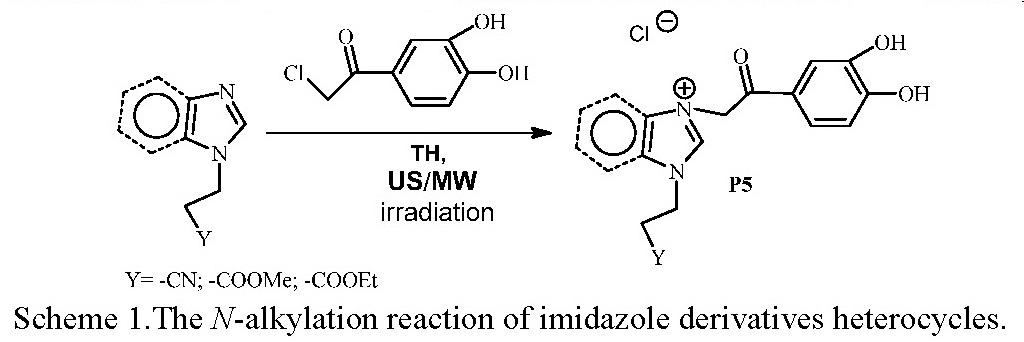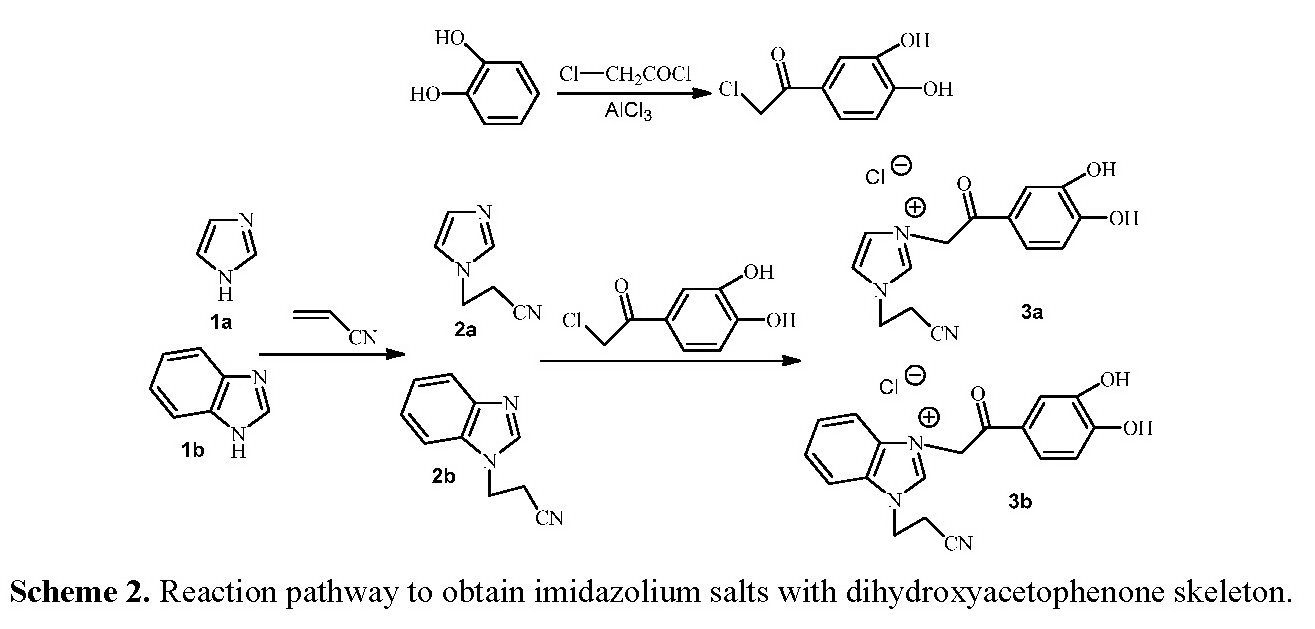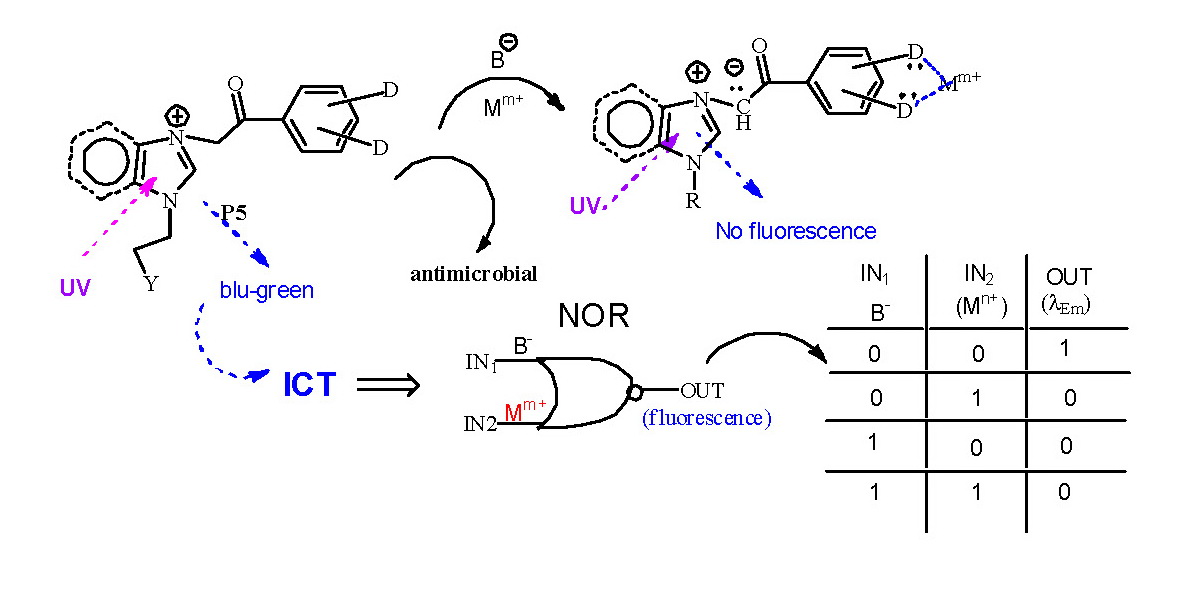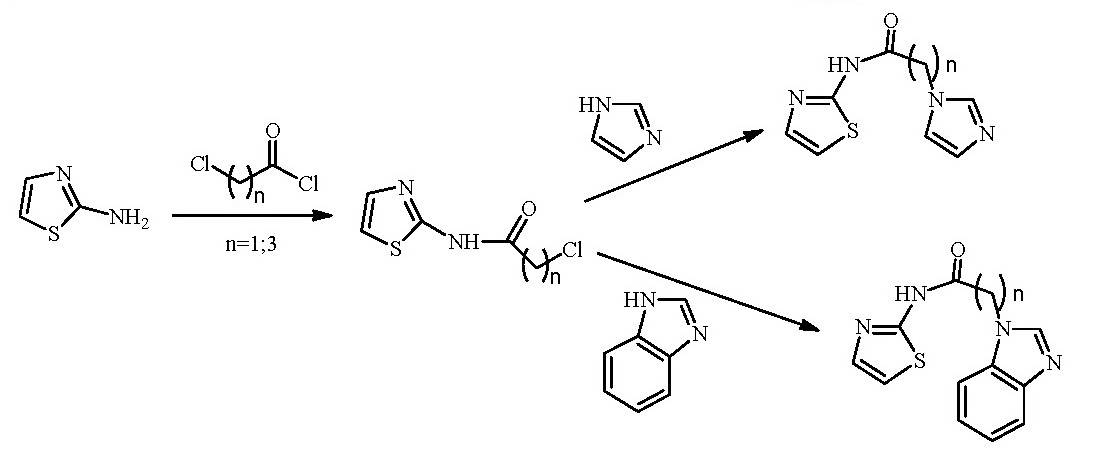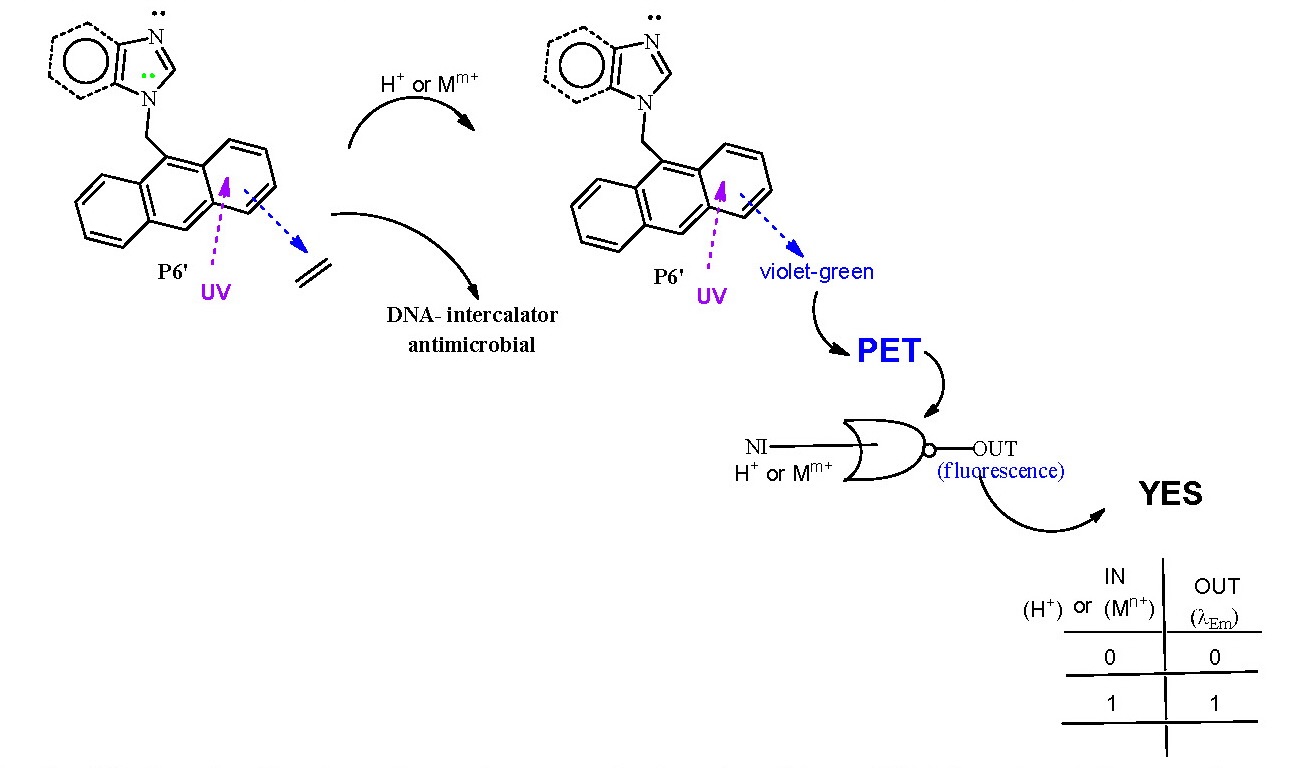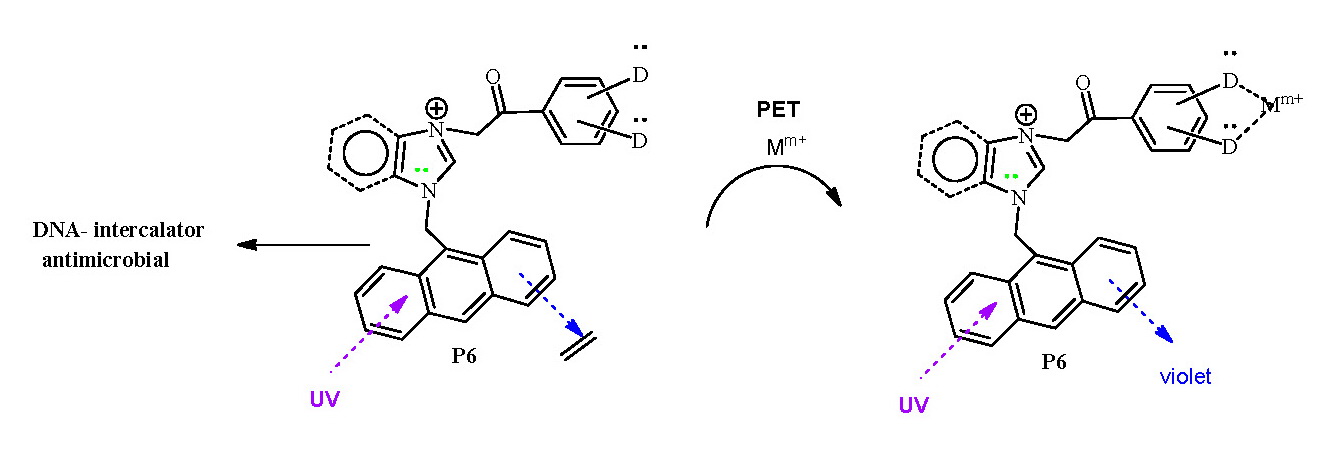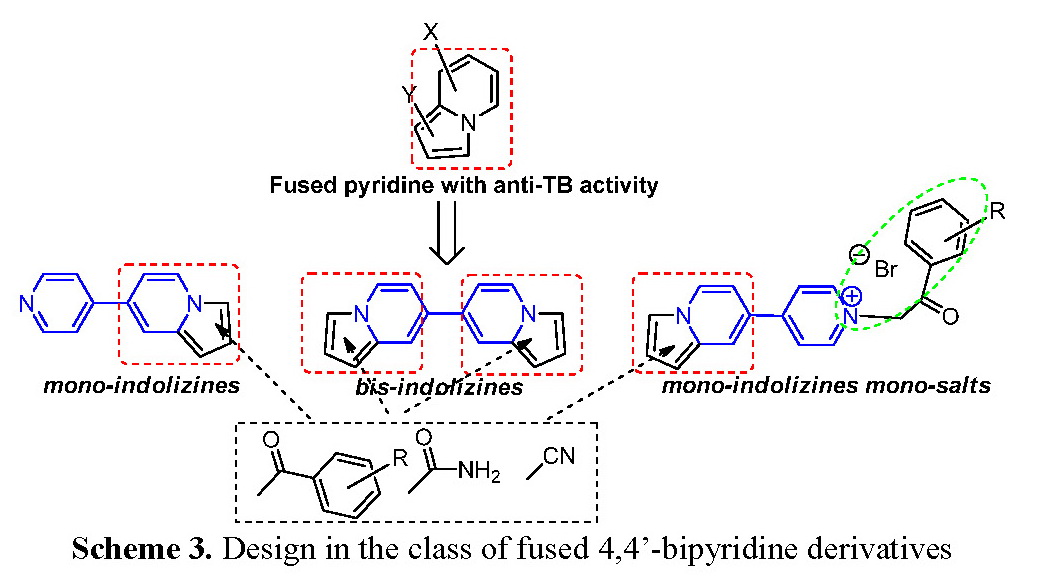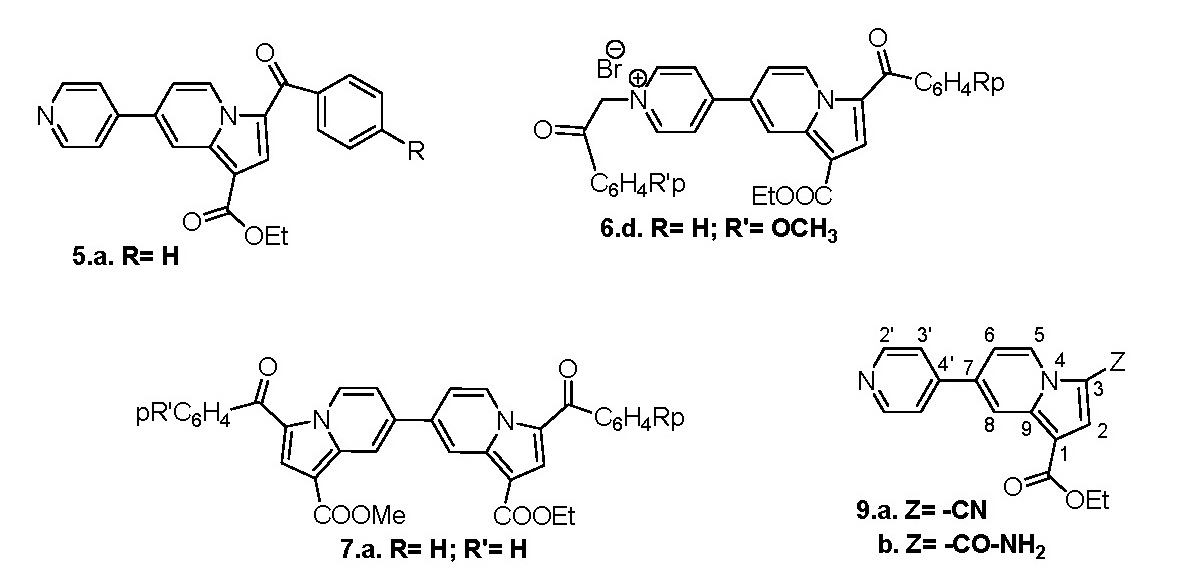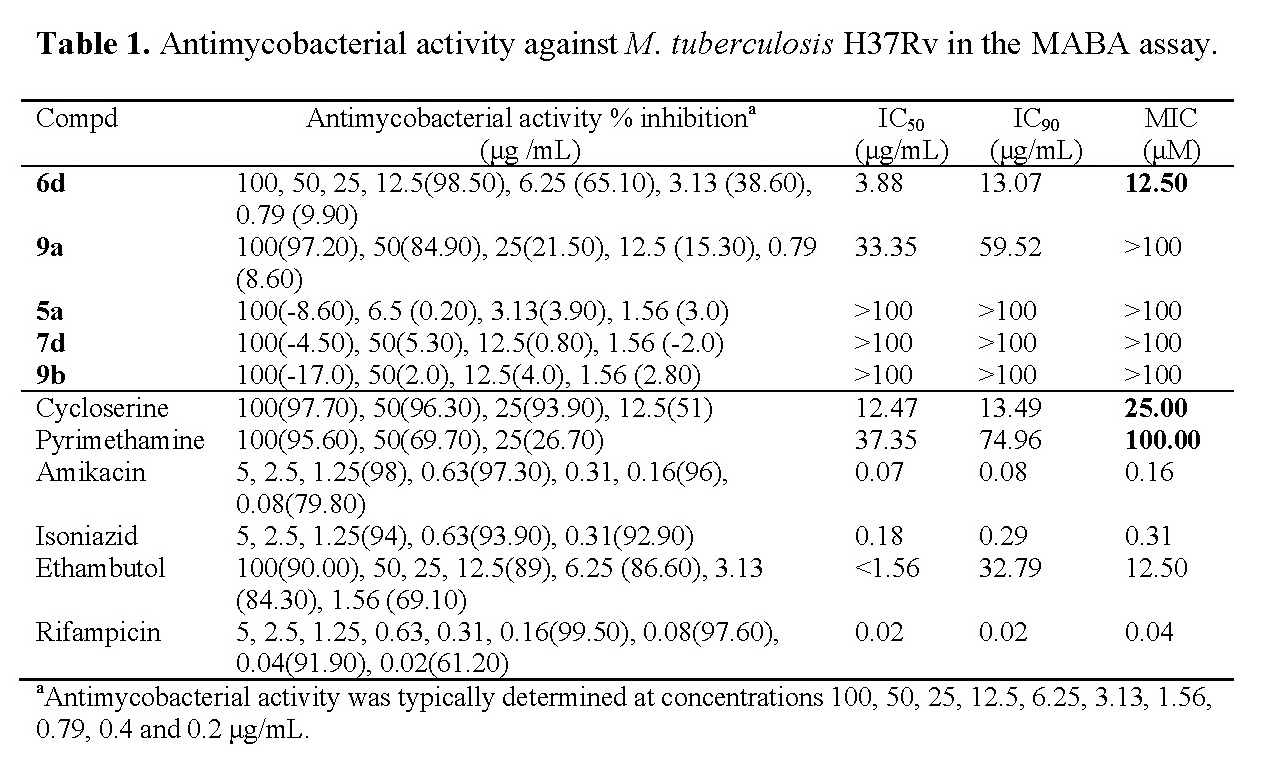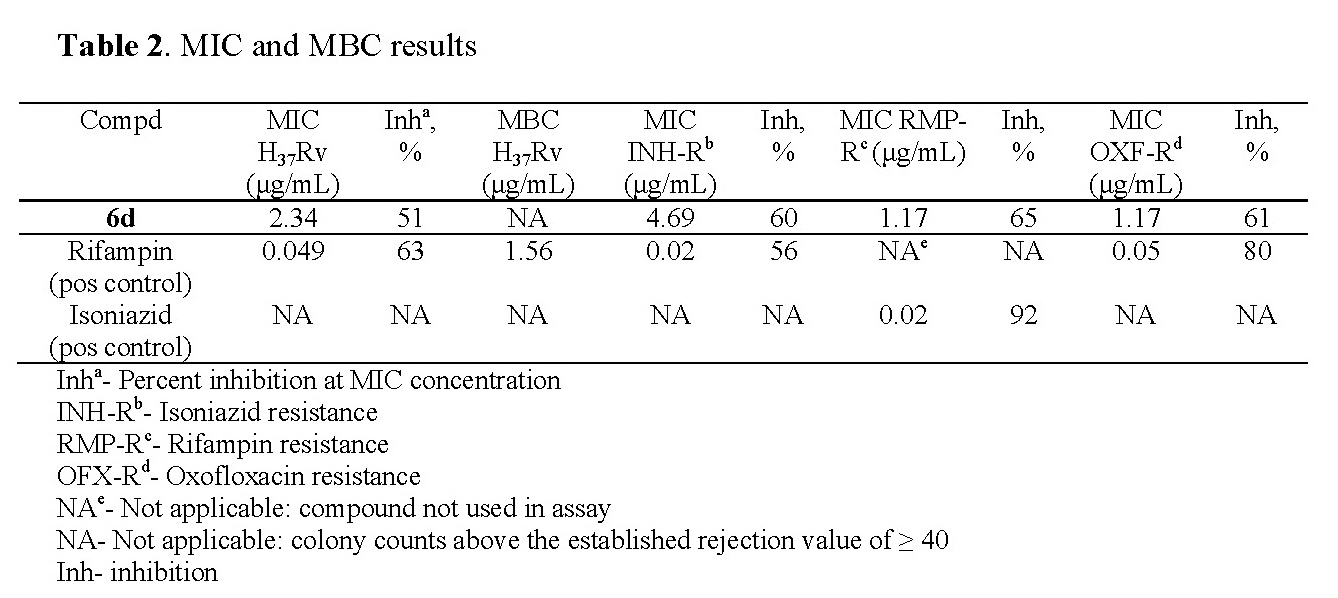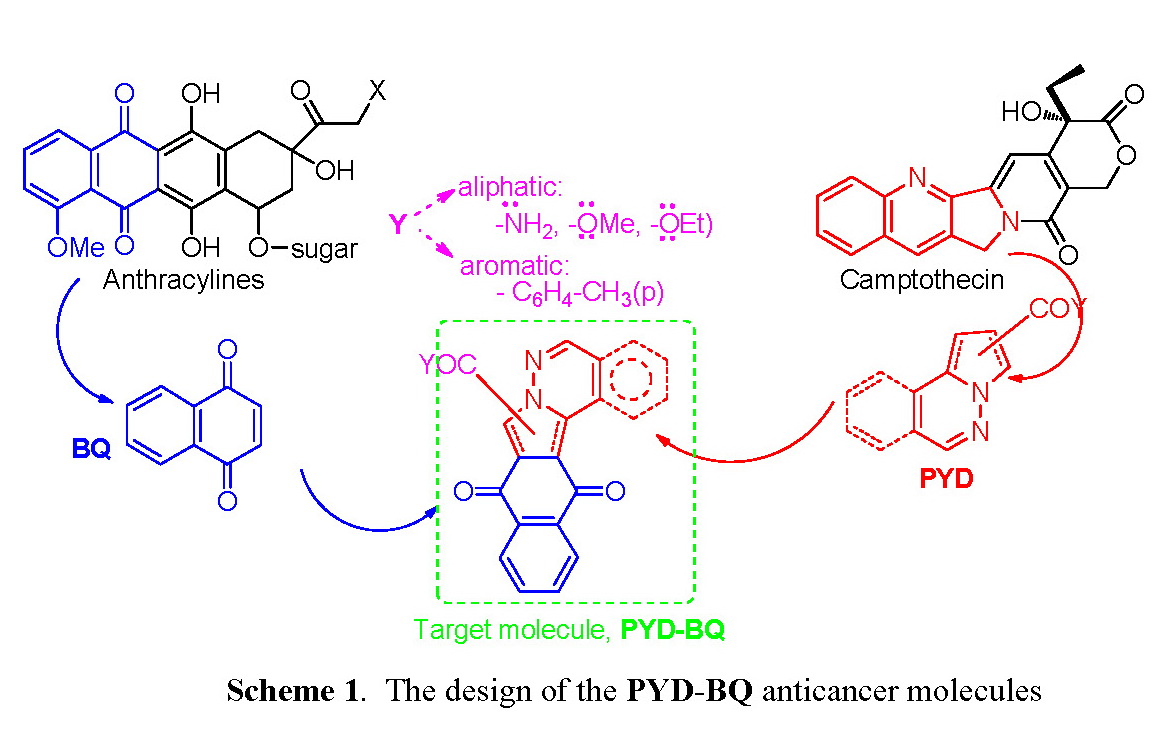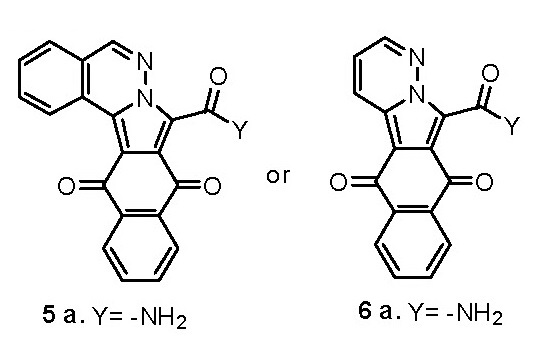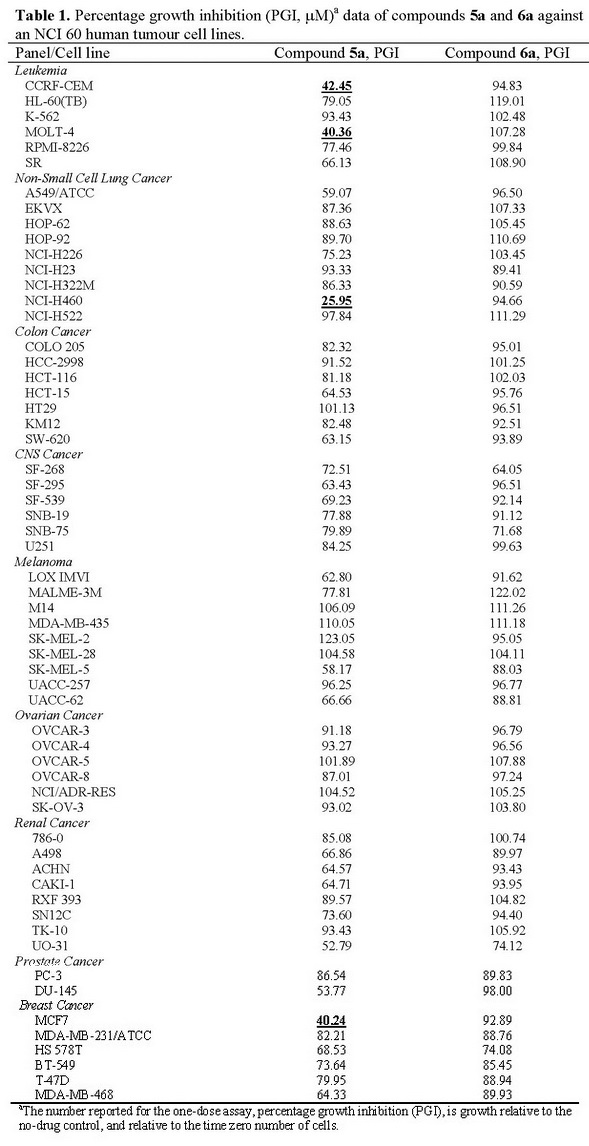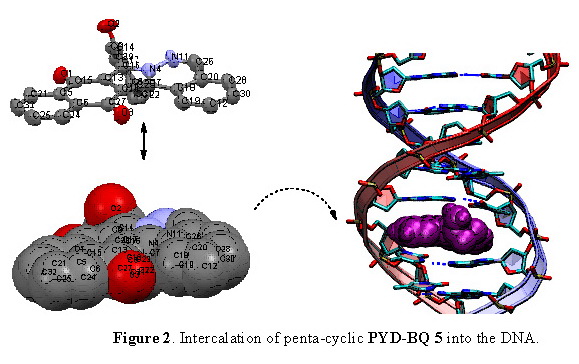2nd Stage Report
2013. Stage II. Synthesis and structural analysis of intermediars and podant derivatives
In this stage there will be bring it contributions to objectives O1, O2, O5-O7.
A.II.1. Synthesis of the necessary intermediary (as we described in stage I)
A.II.2. Synthesis of new nitrogen podant type P5 having in molecule only a π–reach nitrogen heterocycle connected via different spacers with the receptor.
A first class of podants of P5 type have been synthetised via N-alkylation reaction of the five member ring π–reach nitrogen heterocycle. In summary, imidazole and benzimidazole derivatives were N-alkylated with 2-chloro-3’,4`-dihydroxyacetophenone, the corresponding imidazole with dihydroxyacetophenone skeleton derivatives being obtained, Scheme 1.
Some details could be found in a paper that already has been published in Acta Chimica Iasi-2013:
In according with our goal, we decide to study the influence concerning syntheses and biological activity of rationally substituted imidazols. The synthesis of the desired imidazolium salts occurred in several steps. In the first step we synthesize the dihydroxyacetophenone part, namely 2-chloro-3’,4`-dihydroxyacetophenone, using a Friedel – Crafts acylation reaction of pyrochatecol with haloacylchloride. In a subsequent step, we carried out the N-cyanoethylation of the acidic nitrogen from imidazol derivatives (imidazole and benzimidazole) via Michael addition of acrylonitrile.
In the last step of synthesis we combine the two main parts of our designed molecule, imidazolium salts with dihydroxyacetophenone skeleton, using the quaternization reaction of the second nitrogen atom from imidazole with 2-chloro-3’,4`-dihydroxyacetophenone, Scheme 2.
The structure of the newly compounds were assigned by elemental and spectroscopic analysis: IR, 1H NMR, 13C NMR, 2D-COSY, 2D-HETCOR (HMQC), long range 2D-HETCOR (HMBC). If we consider compound 1-(2-cyanoethyl)-3-[(3,4-dihydroxyphenyl)-2-oxo-ethyl]-1H-imidazol-3-ium chloride (3a) as representative, detailed organic structural analysis proved without doubts its structure.
In the IR spectra the most important signals are those one furnished by the stretching vibrations of hydroxyl, cyano and carbonyl ketone group. The hydroxyl appears as a medium (to strong) broad band centred to 3159 cm-1, which is characteristic for phenols with strong intramolecular hydrogen bonding. To 2250 cm-1 (medium to strong) appears the characteristic band for cyano group. The carbonyl ketone group appear as a sharp strong band to 1681 cm-1, which is characteristic for alkyl – aryl ketones.
In the 1H-NMR, the most deshielded signals are those of the hydrogen from hydroxyl groups which appear to 10.44 ppm (s, broaded, 1H: OH from 14-th position) respectively to 9.70 ppm (s, broaded, 1H: OH from 13-th position). These protons are followed by the protons from imidazole ring: 9.34 ppm (s, 1H: H2), 7.99 ppm (s, 1H: H4) and 7.80 ppm (s, 1H: H5). The H2 appears at so low magnetic field, due to the deshielding effect induced by the two neighbourhood nitrogens (one being with positive charge). To 6.01 ppm (s, 2H: H9), appear the methylene protons, due to the powerful deshielding effect induced by the positive nitrogen and dihydroxybenzoyl group. The three protons from the phenyl rings appear to 7.02 – 7.00 ppm (d, J15,16 = 8.0 Hz, 1H: H15) and 7.47 – 7.45 ppm [d (overlapped peaks), 2H: H16, H12). The protons from cyanoethyl group appear to 4.66 – 4.63 ppm (t, J6,7 = 6.4 Hz, 2H: H6) respectively to 3.33 – 3.30 ppm (t, J7,6 = 6.4 Hz, 2H: H7), in accordance with their surroundings.
The 13C-NMR spectrum also confirmed the proposed structures. Thus in the case of compound (3a) the most important signals are those of the carbonyl carbon (C10), cyano carbon (C8), aromatic carbons bearing hydroxyl groups (C13, C14) and imidazole carbons (C2, C4, C5). The carbonyl carbon (C10) is the most deshielded (d= 189.13 ppm), characteristic for alkyl-aryl ketone. The carbonyl carbon is followed in the spectrum by the aromatic carbons bearing hydroxyl groups: to 152.14 ppm appear C14 (para carbonyl, orto hydroxyl) while to 145.70 ppm appear C13 (meta carbonyl, orto hydroxyl). The cyano carbon (C8) appear at typical chemical shift for this type of carbon, 117.178 ppm (CN). The imidazole carbons appear also very deshielded, according with their environment: C2 to 137.83 ppm [a-nitrogens (from position 1 and 5), one being positive charged], C4 to 125.34 ppm (a- positive charged nitrogen, a- carbon C5) and, finally, C5 to 122.01 ppm (a- nitrogen from 1 possition, a- carbon C4); also the relative intensity of the carbons are in according with the proposed structure.
All the remaining signals from IR and NMR spectra are in accordance with the proposed structure.
A second class of podants of P5 type have been synthesised via N-alkylation reaction of the five member ring π–reach nitrogen heterocycle. In order to synthesise this second class of podants of P5 type, initially the bis-etherificated dihydroxyacetophenone was brominated in heterogeneous catalysis using copper (II) bromide, under conventional TH, US and MW irradiation.
The imidazole and benzimidazole derivatives were than N-alkylated with the brominated bis-etherificated dihydroxyacetophenone, the corresponding podants of P5 type being obtained.
The N-alkylation reactions were studied under conventional TH, US and MW irradiation. The reaction under US and MW irradiation were proved to be the most convenient setup procedure for N-alkylation reactions and could be considered environmentally friendly.
In the next step, P5 was tested as chemosensor (complexation with metals, Mm+) and also was tested their ability to function as compounds with antimicrobial and anticancer activity (see also A.II.5). Thecomplexation ability of P5 was tested using bivalent metals (copper and cobalt) and then was tested their ability to function as logic gate via intramolecular charge transfer (ICT). Our results proved that our P5 podant function as a NOR logic gate with two inputs [B– and Mm+] and one output (fluorescence), being a fluorophore-spacer-receptor system. Bellow is presented the logic scheme and true table.
Supplementary activity
We have done the design and then synthesis of new nitrogen podant type, having in the same molecule two p–reach heterocycles, connected via different spacers. As π–reach heterocycles we have used imidazole and thiazole derivatives. The reaction pathway is straightforward, involving 2 steps: acylation of an amine group followed by an N-alkylation:
A.II.3. Synthesis of new nitrogen podant type P3 having in the same molecule at a π–reach and a π–deficient heterocycle connected via different spacers.
In order to reach this goal, we chose again a straightforward and efficient way of synthesis: N-alkylation of imidazole derivatives with bipyride derivatives having in molecule an activated halogen:
In the second step, P3 was tested as chemosensor (complexation with metals, Mm+) and as logic gate of type INHIBIT (two input: H+ and Zn2+and one output: fluorescence), functioning via PET, P3 being a typical fluorophore-spacer-receptor system. Bellow are presented the logic scheme and true table.
A.II.4. Synthesis of new nitrogen podant type P6 having in molecule only a π–reach nitrogen heterocycle connected via different spacers with the receptor.
Synthesis of the new class of nitrogen podants type P6 type having in molecule only a π–reach nitrogen heterocycle connected with the receptor via different spacers have been performed using the following strategy: in first instance was alkylated the imidazole derivatives to N1-nitrogen than, in the second step, the N3-nitrogen was quaternizated via a second alkylation:
The ability of P6 (as well as P6’) to function as chemosensor and as logic gate was than tested. For example, P6’was tested as chemosensor (complexation with metals, M2+) and as logic gate of type YES (one input: H+ or Co2+ and one output: fluorescence), functioning via PET, via a typical fluorophore-spacer-receptor system. Bellow is presented the logic scheme and true table.
As far for P6, the situation is quite analogous, a logic gate of type YES (one input: Mm+ and one output: fluorescence), functioning via PET, via a typical fluorophore-spacer-receptor system, could be described:
A.II.5. Evaluation of the biological active properties
Some of the newly obtained compounds were tested as potential antimicrobials and antitumoral drugs.
In this respect, some bipyridine heterocycles were designed, synthesized and evaluated for their antimycobacterial activities, as model molecules. The primary antimycobacterial screening reveals that some mono-indolizine mono-salts are displaying potency superior to the second-line antitubercular drugs Cycloserine and Pyrimethamine and, equal as the first line anti-TB Ethambutol. The data from Cycle-2 screening assay (MIC, MBC, LORA, intracellular (macrophage) drug screening, and MTT cell proliferation) confirm the promising anti-TB results from cycle-1 for mono-indolizine mono-salts. These data indicate that mono-indolizine mono-salts are potent compounds against both replicating and non-replicating M. tuberculosis, are active against both extracellular and intracellular organisms, has a bacteriostatic mechanism of action and has basically no toxicity.
Some diazine heterocycles were designed, synthesized and evaluated for their antitumoral activity, as model molecules. The in vitro anticancer activity against an NCI 60 human tumour cell line panel, reveal that the more some flat penta-cyclic pyrrolo-diazine-benzoquinone PYD-BQ have a significant antitumor activity. We consider that PYD-BQ molecules will act as an anticancer vector through multiple mechanisms of action: intercalating the DNA, inhibiting the topoisomerase enzymes and, destroying the DNA strands via electron transfer mechanism.
Some more details concerning antimycobacterial activities was appear in a paper accepted for publication in Eur. J. Med. Chem., as following:
Design, biological activity and mechanism of action
Taking into consideration the promising antimycobacterial activity of some fused pyridine derivatives, as well as our previous results in the field of anti-TB derivatives; we have focused on the design of novel structures that incorporate a bis-fused pyridine unit in the molecular scaffold. In this respect, we chose 4,4’-bipyridine heterocycle as main skeleton for synthesis of mono-indolizines, bis-indolizines and mono-indolizine mono-salts derivatives. In equal measure we were interested to study the influence of the fused-pyridine substituents concerning the antimycobacterial activity, Scheme 3.
A selection of compounds (5-9), one representative per each series, was evaluated for in vitro antimycobacterial activity against Mycobacterium tuberculosis, as a part of the TAACF TB screening program under direction of the US National Institute of Health, the NIAID division.
A standard primary in vitro screen was conducted against M. tuberculosis H37Rv (ATCC 27294), in BACTEC 12B medium using the Microplate Alamar Blue Assay (MABA). Compounds that are active in this assay are reconfirmed using a BACTEC 460 Radiometric System. Compounds demonstrating a percent inhibition of bacterial growth ⩾90% in the primary screen were tested in the next stage of the procedure, against M. tuberculosis H37RV to determine the Minimum Inhibitory Concentration (MIC) in the MABA. Compounds were tested in 10 twofold dilutions, typically from 100 μg/mL to 0.195 μg/mL. Rifampicin, Pyrimethamine, Isoniazid, Ethambutol, Cycloserine and Amikacin were used as reference compounds in these assays. MIC was defined as the lowest concentration effecting a reduction in fluorescence of 90%, relative to control. This value was determined from the dose–response curve as the IC90 using a curve-fitting program. IC90 is defined as the concentration effecting a reduction in fluorescence of 90% relative to controls. Compounds with IC90 values ⩽10 μg/mL were considered active antitubercular agents. The results are summarized in Table 1.
As shown in Table 1, compounds 5a, 7d, and 9b did not exhibit antimycobacterial activity (having MIC >100μg/mL when tested in MABA), while compound 9a showed weak inhibitory activity against M. tuberculosis (IC50= 33.35, IC90= 59.52). Notably, 6d was identified as a potent inhibitor against M. tuberculosis, with a MIC value of 12.50 μg/mL in the MABA assay and its antimycobacterial activity was superior to the second-line antitubercular drugs Cycloserine (MIC = 25 μg/mL) and Pyrimethamine (MIC = 100 μg/mL), Table 1. Moreover, 6d have a MIC value equal to the first line anti-TB Ethambutol.
The data from Table 1 illustrate that mono-indolizine mono-salt derivative 6, displays a better antimycobacterial activitycomparative with bis-indolizine 7, suggesting a possible influence of bromine anion concerning antimycobacterial activity.
Compound 6d found promising in primary TB assay, was then subjected to the secondary assay for evaluation of antimcyobacterial activity. These assays included MIC, Minimal Bactericidal Concentration (MBC), Low-Oxygen Recovery Assay (LORA), intracellular (macrophage) drug screening, and MTT cell proliferation.
Minimum Inhibitory Concentration (MIC). The MIC screening was conducted for M. tuberculosis H37Rv (SRI 1345), isoniazid (INH)-resistant M. tuberculosis (SRI 1369), rifampin (RMP)-resistant M. tuberculosis (SRI 1367), and ofloxacin (OFX)-resistant M. tuberculosis (SRI 4000). MBC, LORA and intracellular drug screening assays were conducted using only M. tuberculosis H37Rv (SRI 1345). The MIC for each compound was determined by testing ten, two-fold dilutions in the following concentration ranges: 75 to 0.146 μg/mL for MIC and LORA, respectively 75, 7.5 and 0.75 μg/mL for macrophage and MTT.
MIC is reported as the lowest concentration (μg/mL) of drug that visually inhibited growth of the organism. In addition, the percentage of inhibition at MIC is provided. These data are briefly presented in Table 2.
The MIC was 2.34 μg/mL and the percentage of inhibition at MIC concentration was 51%, suggesting that compound 6d is potent against replicating M. tuberculosis H37Rv (SRI 1345). The results obtained against drug resistant strains exhibited similar values of MIC.
Minimal Bactericidal Concentration (MBC). The MBC is determined subsequent to MIC testing by sub-culturing diluted aliquots from wells that fail to exhibit macroscopic growth. The MBC is defined as the lowest concentration (μg/mL) of compound exhibiting 99.9% kill over the same time period used to determine MIC (18-24 h). MBC values 16 times higher than MIC, typically indicate antimicrobial tolerance. The established rejection value of ≥40 colonies for the MBC assay was based on the calculated concentration of M. tuberculosis in the MIC plates. The results, reported as μg/mL concentration, are determined based on Colony Forming Units (CFUs) enumerated from agar plates. Only agar plates with countable colonies have reportable counts. If a compound lacks bactericidal activity, many times the CFUs are too numerous to count (TNTC) and are thus reported accordingly. As far for compound 6d, the MBC value (Tabele 2) are above the established rejection value of ≥40 colonies and the CFUs are too numerous to count. These results suggest an antimicrobial tolerance.
Low-Oxygen Recovery Assay (LORA). Traditional screening of drugs against M. tuberculosis only addresses or targets the organism in an active replicating state. It is well known that M. tuberculosis can reside in a state of non-replicating persistence (NRP) which has not been adequately assessed in the development of new antimicrobials. The LORA assay tests drugs for activity against M. tuberculosis in a state of NRP. LORA test was conducted in duplicate and the following controls were included in each test plate: i) medium only (sterility control); ii) organism in medium (negative control); and iii) rifampin or isoniazid (positive control). Results for the LORA assay are reported as the lowest concentration (μg/mL) of drug that visually inhibited growth of the organism. The data are summarized in Table 3.
The LORA assay test for compound 6d displays a value of 1.17 μg/mL, suggesting that compound 6d was potent against non-replicating M. tuberculosis.
The Intracellular (macrophage) Drug Screening, and MTT cell proliferation (MTT). This assay evaluates intracellular drug effectiveness. Briefly, the purpose of this assay is to assess the inhibition of M. tuberculosis H37Rv phagocytised by J774.A1 macrophages when exposed to a battery of test compounds. J774.A1 is an adherent macrophage cell line originating in mice routinely used for the determination of inhibition of intracellular pathogens. The macrophages are subsequently lysed and plated onto Middlebrook 7H10 agar plates for bacterial enumeration. The number of mycobacteria surviving treatment is compared to the number of mycobacteria not receiving treatment in order to determine the intracellular activity of the test compounds.
Each compound was tested in duplicate, using 3 concentrations, and rifampin was used as the positive control drug. The three concentrations chosen were based on the MIC data generated in HTS primary screen. The mid concentration bracketed the reported MIC with the lower concentration ten-fold below the mid and the higher concentration ten-fold above the mid. Intracellular drug activity is reported as log reduction value calculated as reduction in M. tuberculosis concentration from zero hour to 7 days post-infection. The data are presented in Table 3. A drug cytotoxicity control plate assay (MTT proliferation) was also conducted in parallel using uninfected macrophages to confirm that concentrations utilized for testing were not toxic to the macrophages. Drug cytotoxicity is reported as cell proliferation, or percentage of viability. These data are summarized in Table 3.
As we may notice from Table 3, the log reduction value for compound 6d, is almost equal to control drug rifampin at low concentration and almost double at mid and high concentrations. These results suggest that 6d is a potent compound against intracellular M. tuberculosis.
We may also notice from Table 3 that the MTT viability for compound 6d (at low and intermediate concentrations) is close to control drug rifampin, suggesting that compound 6d has basically no toxicity at these concentrations. However, taking into consideration that at high concentrations the MTT viability for compound 6d is lower than 10%, we may only to presume that the activity of compound 6d is not due to cytotoxicity of compound. Further studies remain to be done in this respect.
Some more details concerning antitumoral activity appear in a paper published in Med. Hyp., 82, 11-15, 2014, as following:
Anthracylines Anthracylines (ANT), camptothecin and its derivatives (CPTs) are two well know classes of drugs largely used in cancer therapy, Scheme 1. Several different mechanisms have been proposed to explain the ANT anticancer activity, three of them being widely accepted: intercalators of DNA (the planar ring system inserts between two DNA base pair), topoisomerase II inhibitors (causing double-strand breaks) and DNA strand breakers via electron transfer mechanism (quinone/semiquinone couple). As far for CPTs derivatives, they are the leading structures for Topo I inhibitors and also could intercalate the DNA.
Having in view the above consideration and, as a part of our work in the field of biologically active compounds [4, 5, 13-17], we have designed a new type of anticancer molecule, containing in the same molecule two pharmacophore main sites: a pyrrolo-diazine (PYD) moiety and a benzoquinone (BQ) one, Scheme 1.
The PYD graph is represented by a fused pyrrolo- pyridazine (or phthalazine) moiety, having in the same structure an electron p-reach ring (pyrrolo moiety) and an electron p-deficient 1,2-diazine (pyridazine or phthalazine derivatives). The Y-substituent onto the PYD graph is an electron reach group, aliphatic or aromatic. The benzoquinone (BQ) moiety is fused with the pyrrolo ring from PYD, in order to realise a molecule as flat as it is possible. As to the mechanism, we hypothesize that, the PYD graph will act as a Topo I inhibitor (similar to CPTs) and as DNA intercalator (via the nitrogen atoms from nitrogen heterocycles and Y-electron reach groups, which will be able to interact via noncovalent bonding with the electron deficient active sites from DNA). The BQ graph will act as a Topo II inhibitor (similar to ANT) and DNA strand breakers via electron transfer mechanism (quinone/semiquinone couple). As a whole, our PYD-BQ molecule is flat, consisting in four or five fused aromatic rings, and will realise the intercalations between the base pairs of DNA. Overall, the designed PYD-BQ molecule will act as an anticancer vector through multiple mechanisms of action: intercalating the DNA, inhibiting the topoisomerase enzymes and destroying the DNA strands via electron transfer mechanism.
Biological Activity
A selection of compounds (5a and 6a) was tested in vitro for anticancer activity by the National Cancer Institute (NCI, USA), under the Developmental Therapeutics Program (DTP), at a single high dose [10-4 M] cell assay.
This assay was performed in a 60 human tumour cell line panel, representing leukemia, melanoma and cancers of lung, colon, brain, breast, ovary, kidney and prostate, in accordance with the protocol of the NCI. Results for each compound were reported as a Mean Graph of the growth percent of the treated cells when compared to the untreated control cells and is available for analysis by the COMPARE program (Table 1).
The results are express as “percentage growth inhibition” (PGI) term, and represent growth relative to the no-drug control, and relative to the time zero number of cells. The results from Table 1 indicate that PYD-BQ 5a exhibit a significant antitumor growth inhibitory activity (more than 60%) when tested on Leukemia CCRF-CEM, Leukemia MOLT-4, Non-Small Cell Lung Cancer NCI-H460, and Breast Cancer MCF7. The fact that the penta-cyclic compounds type PYD-BQ 5 have anticancer activity while the tetra-cyclic PYD-BQ 6 have not, make us to hypothesize that from the above described mechanisms of action, the intercalation with DNA have the major contribution. As we already show previously in the X-ray structure (Fig.1), these types of molecules are fully coplanar. Despite of the fact that both molecules type 5 and 6 are flat, compounds type PYD-BQ 5 being penta-cyclic, are more bulky than PYD-BQ 6 (which are tetra-cyclic only), fact that could explain the better intercalation with the DNA and consequently their anticancer activity. It is very likely that the intercalation process will be also favoured by the hydrogen bounds that could take place via nitrogen atoms from heterocyles and amide, oxygen from ketone and ester groups and the halogen atoms (fluorine and chlorine).
A.II.6. Elemental and structural analysis of the obtained structures. Final stage report
The structure of the newly compounds was proven through elemental and structural analysis: IR, NMR, UV-Vis and fluorescence, MS, X-ray.
A final stage report was accomplished and it was presented on the web page of the project.
Achievements
Results Disseminations
- Papers published or accepted for publication: 6
1.Dorina Mantu, Eliza Ene, Vasilichia Antoci, Ana Maria Zbancioc. Diazolium Salts with Dihydroxyacetophenone Skeleton with Anticipated Anticancer and Antibacterial Activity, Acta Chimica Iasi, 21, 9-18, 2013. Publisher: Ed. Universitatii Al.I.Cuza Iasi, Romania. ISSN (Online) 2067-2446,ISSN (Online) 2067-2446, DOI: 10.2478/achi-2013-0002
2.Zbancioc, A.M.; Miron, A.; Moldoveanu, C.; Zbancioc, Ghe. Imidazolium Salts with Dihydroxyacetophenone Skeleton with Anticipated Anticancer Activity. Part II, Rev. Chim. Bucharest, 64(6), 584-586, 2013. Publisher: SYSCOM 18 SRL, CODEN: RCBUAU ISSN: 0034-7752. ROMANIA ISI-0.619
3. Balan, A.M.; Zbancioc, Ghe.; Mangalagiu, I.I. Ultrasound and microwave assisted synthesis of dihydroxyacetophenone derivatives with or without 1,2-diazine skeleton, Ultrason. Sonochem., 21, 802-811, 2014. Publisher: Elsevier B.V., CODEN: ULSOER ISSN: 1350-4177. doi:10.1016/j.ultsonch.2013.09.012 ISI-3.567
4.Danac, R.; Mangalagiu I. I.: Antituberculosis activity of nitrogen heterocycles derivatives: bipyridine derivatives. Part III, Eur. J. Med. Chem, 000, 1-7, 2013. http://dx.doi.org/10.1016/j.ejmech.2013.09.061 ELSEVIER FRANCE-EDITIONS SCIENTIFIQUES MEDICALES ELSEVIER, FRANCE , ISSN: 0223-5234. ISI- 3.499
5.Balan, A.M.; Miron, A.; Tuchilus, C.; Rotinberg, P. Mihai, C.T.; Mangalagiu, I.I.; Zbancioc, Ghe. Syntheses, Antimicrobial and Antitumoral Activity of Some Novel Dihydroxyacetophenone Derivatives, Med. Chem,, accepted, 2013. Publisher: Bentham Science Publishers ISSN: 1573-4064 (Print) ISI-1.496
6.Bejan, V.; Mantu, D.; Cozna, D.G.; Ursu, C.; Mangalagiu, I.I.: Design, synthesis and in vitro cytotoxicities of new tetra- and penta- cyclic azasteroids against human tumor cell lines, Med. Hyp., 82, 11-15, 2014. doi: 10.1016/j.mehy.2013.10.024 PERGAMON-ELSEVIER SCIENCE LTD, ENGLAND. ISSN: 0968-0896 ISI- 1.15
- Papers presented to Scientific Meetings: 8
1. Mangalagiu, I.I.: NEW “SMART” VERSATILE BUILDING BLOCKS FOR MULTIPLE TASKS, ZILELE ACADEMICE IEŞENE, A XXIV-a Sesiune de Comunicări Ştiinţifice a Institutului de Chimie Macromoleculară „Petru Poni” Iaşi, PROGRESE ÎN ŞTIINŢA COMPUŞILOR ORGANICI ŞI MACROMOLECULARI, October 3 – 5, 2013. C4, pag.22: Plenary lecture.
2.Mantu, D.; Bejan, V.; Moldoveanu, C.; Shova, S.; Mnagalagiu, I.I. NMR and X-ray complete characterisation of some unexpected fused azaheterocycles. European Exhibition of Creativity and Invovation, Euroinvent 2013, May 9-11 2013, Iasi, Romania. Class 10, 20.1, pag. 152. Poster, ISBN 978-973-703-891-3. http://eudirect.ro/euroinvent/
3. Bejan, V.; Mantu, D.; Zbancioc, Ghe.; Mnagalagiu, I.I. Synthesis of new azaheterocyclic compounds using eco-friendly methods. European Exhibition of Creativity and Invovation, Euroinvent 2013, May 9-11 2013, Iasi, Romania. Class 10, 20.2, pag. 153. Poster, ISBN 978-973-703-891-3. http://eudirect.ro/euroinvent/
4. Mangalagiu, I.I. Azaheterocycles: an efficient way towards derivatives with multiple functions, “Al.I.Cuza“ University Days, October 31-st – November 2-nd, 2013. Iasi, Romania. C14, pag.14. Plenary lecture. ISSN 2067 – 2438; ISSN (online) 2067 – 2446. http://aci.chem.uaic.ro (Supplement of the Acta Chimica Iasi journal)
5. Mantu, D.; Antoci, V.; Zbancioc, Ghe.; Moldoveanu, C.; Nicolescu, A.; Ciobanu, C.; Mangalagiu, I.I.: Synthesis and characterization of new imidazole/benzimidazole salts, “Al.I.Cuza“ University Days, October 31-st – November 2-nd, 2013. Iasi, Romania. P2, pag.36. ISSN 2067 – 2438; ISSN (online) 2067 – 2446. http://aci.chem.uaic.ro (Supplement of the Acta Chimica Iasi journal)
6. Antoci, V.; Mantu, D.; Zbancioc, Ghe.; Moldoveanu, C.; Nicolescu, A.; Ciobanu, C.; Mangalagiu, I.I.: New bis-imidazolium salts: synthesis and NMR characterization, “Al.I.Cuza“ University Days, October 31-st – November 2-nd, 2013. Iasi, Romania. P6, pag.40. ISSN 2067 – 2438; ISSN (online) 2067 – 2446. http://aci.chem.uaic.ro (Supplement of the Acta Chimica Iasi journal)
7. Mengheres, Ghe.; Antoci, V.; Mangalagiu, I.I.: Synthesis, spectral investigation and X-ray structure of 2,2’-bipyridyl-3,3’-dimethanol, “Al.I.Cuza“ University Days, October 31-st – November 2-nd, 2013. Iasi, Romania. P7, pag.41. ISSN 2067 – 2438; ISSN (online) 2067 – 2446. http://aci.chem.uaic.ro (Supplement of the Acta Chimica Iasi journal)
8. Ene (Plesnicute), E.L.; Antoci, V.; Mantu, D.; Mangalagiu, I.I.: Eco-friendly synthesis of new nitrogen heterocycles compounds using ultrasound irradiation, “Al.I.Cuza“ University Days, October 31-st – November 2-nd, 2013. Iasi, Romania. P21, pag.55. ISSN 2067 – 2438; ISSN (online) 2067 – 2446. http://aci.chem.uaic.ro (Supplement of the Acta Chimica Iasi journal)
- Awards
– May 9-11, 2013. “Excellency Diploma”, Paper awarded: “NMR and X-ray complete characterisation of some unexpected fused azaheterocycles”. Euroinvent 2013, Iasi, Romania;
– May 9-11, 2013. “Excellency Diploma”, Paper awarded: “Synthesis of new azaheterocyclic compounds using eco-friendly methods”. Euroinvent 2013, Iasi, Romania;
